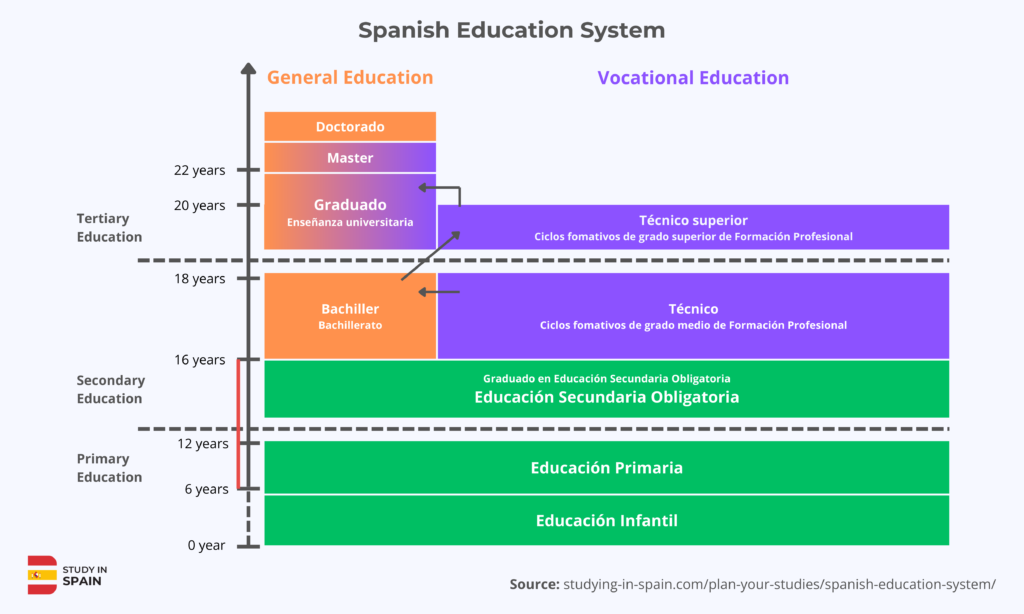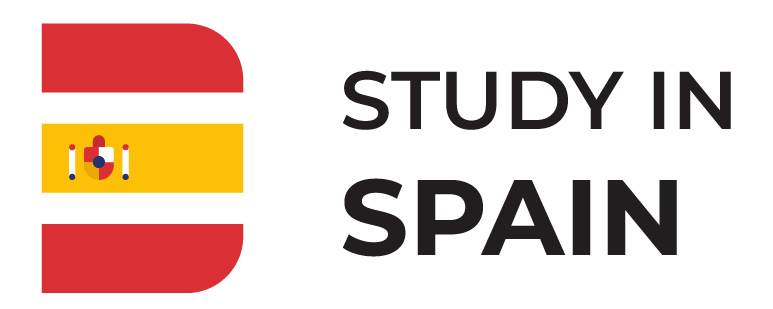The Spanish education system is supported by the national government and the individual governments of each of the 17 autonomous regions in Spain. Elementary (primary) and middle (secondary) school in Spain are compulsory and free for all children between the ages of 6 to 16. After finishing secondary education, students will be awarded a graduation certificate, and will be able to proceed to higher education if they wish.
It is not difficult to understand the education system in Spain for it is largely comprehensive and efficient. The Spanish education system is accessible even if language barriers are present. In Spain, you will be able to find both, international as well as Spanish schools. Through the years, there have been certain changes in the education system in Spain, mainly consisting of an improvement in educational reforms, such as teaching, curriculum, infrastructure, and quality.

StudiesIn is the #1 digital student consultancy for studies in Spain and provides end-to-end services and counselling for students and parents.
StudiesIn offers guidance to students from the moment they decide to study abroad to local relocation support in Spain to finding a job after graduation, arranging all necessary legal permits along the journey.
Read moreIn the below sections, you will find everything related to the education system in Spain, including the structure of the education system, facts about Spain’s education system, all the way to higher education.
Here is everything you need to know about the Spanish education system:
Structure of the Education System in Spain

The education system in Spain is divided into four stages (all mentioned below), two of which are optional, preschool and upper secondary education, and the other two are compulsory, specifically primary and secondary education. Learn more below:
Nursery and Preschool in Spain
Nursery and preschool education in Spain are completely optional. Nursery school (guarderia) is usually not funded by the state, which means parents/guardians will be required to pay fees to take their children to nursery schools. Nurseries take children up to three years.
Preschool, on the other hand, is free of charge, and takes children up to six years of age. During this time, children develop their physical and mental skills, learn reading, writing, and the alphabet. This stage is not academic as much as it teaches children numerous real-life skills.
Primary Education
Primary education is mandatory in Spain, it begins at 6 years old and ends at 12 years old. It is made up of three cycles, each of which lasts 2 years. This stage of education is free and students usually learn general subjects like languages, mathematics, literature, natural and social sciences, and arts. Students also have physical education classes during primary education. Primary education allows students to develop subject-specific interests while offering a wide range of subjects.
During primary education, students are graded on each subject, with the highest grade being sobresaliente (SB), which means outstanding and the lowest grade being insufficient (IN). The year should be repeated in case students do not earn the necessary grades/results at the end of each cycle.
Secondary Education
Secondary education (Educación Secundaria Obligatoria) is the third stage of Spanish education system, and, as so, it is also compulsory. Secondary education includes students in the age range between 12 and 16 years old. The secondary education system in Spain includes state schools, private schools, or state-funded private institutions. Unlike primary education, secondary education has only two cycles, the first cycle includes years 1–3, while the second cycle is year 4. Obligatory secondary education in Spain ends at the age of 16.
*During secondary education, students get to learn the same subjects as in primary education but on a more advanced level. Specifically, students will likely still have to go through language subjects, literature, mathematics, history, biology, and geography. Students can also choose from a wide range of optional subjects, which can be in fields like music, foreign languages, sciences, or the arts. Just like in primary education, students who do not receive sufficient results at the end of the year will be asked to repeat the year.
After finishing obligatory secondary education in Spain with sufficient results, students are awarded a Graduate of Secondary Education Certificate or a School Certificate.
*Changes have occurred in Spanish secondary education. What has changed?
On April 4th, 2022, Spain’s Council of Ministers approved a Royal Decree stating the changes in the Spanish Compulsory Secondary Education (Educación Secundaria Obligatoria, ESO).
Here is a brief summary of the changes according to the new educational law (LOMLOE):
- The changes are applicable starting the 2022-2023 academic year for the first and third years of ESO.
- Starting the 2023-2024 academic year, the changes will be applicable for the second and fourth years as well.
- The goal of these changes is to highlight critical thinking and reasoning rather than mechanical methods of learning. The new curriculum favors the students’ ability to apply knowledge in real-world situations instead of simple theoretical learning.
- The new curriculum introduces new concepts, including gender equality, sex education, and health education, to name a few.
- New subjects are added, including Technology and Digitisation.
- Hours allocated to each subject have also changed. The most number of hours is allocated to Spanish Language and Literature, followed by the new subject of Technology and Digitisation.
- The teachers will decide whether students move from one course to another, depending on whether students have met the key objectives.
Upper Secondary Education
Upper secondary education is optional for students in Spain. After finishing obligatory secondary education, students in Spain may either choose to undertake 2-year studies for the Bachillerato certificate, which makes them eligible for university education, or vocational training which will make them eligible for the skilled-job market.
The upper secondary education in Spain includes the following:
1. Bachillerato
In order to earn the Bachillerato certificate (Spanish Baccalaureate), 16-year olds who have finished secondary education in Spain, should go through a two-year period of studies and undertake an exam at the end. This certification will allow students to enter university and proceed to further stages of higher education. Specifically, after earning the Bachillerato, students may choose to undertake vocational training or take the tests for admission to university, known as “Selectividad”.
Bachillerato is organized in a flexible way, allowing students to receive specialized training in numerous branches like sciences, humanities and social sciences, as well as arts. For the duration of two years, there are three sets of subjects including core subjects, specific subjects, and subjects that are structured by the Autonomous Communities.
2. Vocational
Vocational training (Ciclos Formativos) in Spain allows students to obtain training in numerous working skills, lasting for the duration of four years. Students may either undertake Grado Medio, which provides basic training and lasts for two years, or undertake Grado Superior, and thus go through an additional two years. The latter can only be started when the student is of 18 years of age, meaning even students who have passed Bachillerato may have access to it in case they want to receive vocational education.
3. Universities
Higher education in Spain comprises 89 universities, 50 of which are funded by the state. To enter university in Spain, students must have received their Bachillerato certificate as well as have passed their university entrance exams known as ‘Selectividad’.
Spain’s higher education sector is excellent, and it attracts not only Spanish students but also students from abroad. From approximately 1.6 million students in the higher education sector, there are around 224,080 international students enrolled in Spanish universities, out of which 53,858 are international students on mobility programmes.
The education system in Spain has a variety of benefits by properly preparing students for the labour market and providing high quality education, and qualifications recognized worldwide.
Frequently Asked Questions – FAQs
Is the Education System in Spain Decentralized?
Yes, one of the main characteristics of the education system in Spain is its decentralisation. This means that Spain’s education system shares educational competencies between the General State Administration (Ministry of Education and Vocational Training) and the authorities of each of the autonomous regions, respectively their Departments for Education.
What Languages Are Used in the Education System in Spain?
Spanish state schools teach students in the Spanish language, with occasional exceptions when they use Catalan or Basque, meaning certain places in Spain teach in the co-official language of the region. Schools usually provide extra lessons for students who need help with the language, especially in areas where there are a lot of internationals.
Universities in Spain offer degree programmes taught in Spanish (carreras universitarias), but there are also options for international students where classes are offered in English. There is also the option of bilingual classes, which use both Spanish and English.
Are There International Schools in Spain?
Yes, you will be able to find international schools in Spain, although most families send their children to local schools, which are free of charge. An international school, however, makes it easier for foreign students to continue education in their language before learning Spanish.

